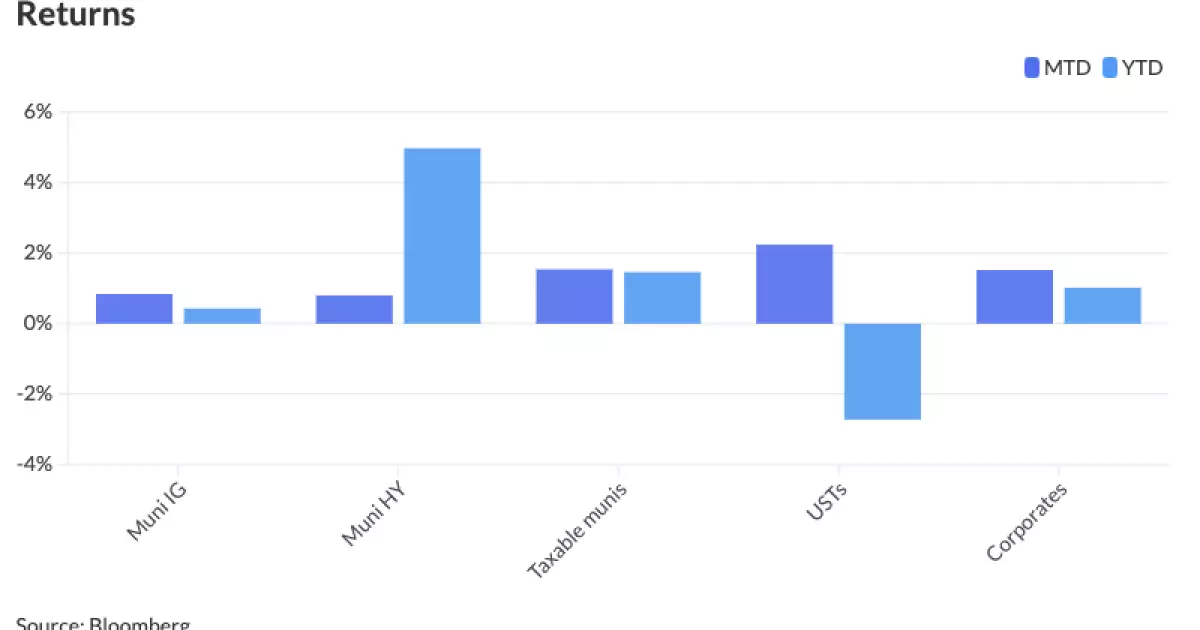The municipal bond market is displaying some intriguing shifts as the U.S. economy languishes in a mixed performance between Treasury yields and equity performances. Despite an overall steady trend in municipal bonds, recent fluctuations raise significant questions and opportunities for investors navigatingこの space.
On a recent Monday, municipal bonds showed minimal change even though U.S. Treasuries were exhibiting firmness. This lack of visible changes reflects a continuation of stability in the municipal market that has characterized recent trading sessions. Jason Wong, vice president of municipals at AmeriVet Securities, remarked that despite a minor drop in yields by 15 basis points on average across the curve this month, yields remain comparatively higher than at previous points this year. Notably, the 10-year municipal bond yield fell by 2.2 basis points last week, concluding at 2.78%. Yet, this drop does not obscure the fact that year-to-date yields are still elevated compared to the start of the year, when they stood at 2.28%.
The ongoing trend of higher yields in the municipal space, juxtaposed with their lower ratios compared to Treasuries, suggests that they are relatively cheaper. The data reveals a 10-year muni-to-Treasury ratio of 58.48% at the year’s onset, but it remains rich when viewed through the lens of a longer historical average of 86.50%. This data points to a nuanced picture for investors who seek judicious selections in the municipal bond space.
Interest Rates and Future Projections
Market analysts are closely watching the Federal Open Market Committee (FOMC) meeting, anticipating that discussions surrounding the easing of inflation might play a pivotal role in upcoming interest rate adjustments. Wong has speculated that with indications of an easing inflation rate, Federal Reserve Chair Jerome Powell might signal potential rate cuts, with even a possibility of such cuts taking effect as early as September.
This potential shift in monetary policy could spur increased issuance in the municipal market, as reduced rates historically attract more issuers. Wong emphasized, “If the Fed cuts rates in September, we should expect to see issuers flock back to the markets.” The interplay of market conditions indicates a finely balanced landscape, with a downturn in new issuance around $6.6 billion anticipated this week due to the FOMC meeting, further underlining the caution prevailing among market participants.
A review of the primary market showcases a significant activity by major financial institutions. For example, Wells Fargo initiated a one-day retail period on $1.106 billion in general obligations for New York City, resulting in robust offerings across varied maturity bonds. In addition, Goldman Sachs facilitated the pricing of $638.745 million in gas project revenue bonds for the Black Belt Energy Gas District, indicating a healthy demand in specific bond segments.
This backdrop of sizable issuances contrasts with the overall slowing of issuance, thus positioning the municipal market at a potential tipping point. Strategists from Birch Creek Capital expressed cautious optimism, indicating that as investors shift their focus to more attractive new issues, the demand for existing positions may wane temporarily.
Secondary Market Observations
According to reports from LSEG Lipper, inflows into municipal bond funds reached $866 million last week, echoing a positive sentiment in long-term funds, although this marked a slight decrease from the previous week’s $906 million inflow. Meanwhile, customer buying activity remained stable, although marginally up compared to recent volumes, highlighting the dynamic yet careful engagement of market participants.
The secondary market also experienced elevated selling activity, reflecting a 35% increase in bid wanted in competition volumes. These metrics suggest a notable shift toward new issue opportunities, indicating strategic rotations among investors aiming for optimized positions.
With a bevy of upcoming issuances, ranging from major airport revenue bonds in Portland to healthcare revenue bonds in Virginia, the stage is set for a critical evaluation of future investment strategies. Remaining attuned to economic indicators, particularly surrounding the FOMC’s interest rate discussions, will be paramount for municipal bond investors.
Overall, the municipal market seems resilient, with a mindful balance amidst historical challenges and emerging opportunities. As the market awaits clearer signals from the Federal Reserve, investors are advised to stay informed and agile, preparing to pivot based on prospective economic developments, particularly those related to interest rates and market demand. As we transition through these understanding market phases, the municipal bond landscape will undoubtedly remain a focal point for savvy investors aiming to leverage changing economic tides.


Leave a Reply